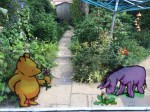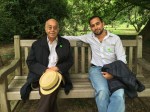As the taxi drove up to 60 Radway Road, my brain started making connections and activating memories which had long been luckily stored in my head. Not forgotten, just put away for far too long.
It had been more 26 years since I was first here and ten since my last visit: Southampton, England. Home of Professor Arjan Shahani, an incredible, intelligent, knowledgeable and lovable man I am lucky to call my uncle and the one I proudly take my name after.
I pushed the green wood gate open and rang the doorbell next to the green door, excited to greet Prof. Shahani. While I was really happy just for the fact of seeing him, I did not anticipate I would find so many other reasons to be happy after I walked through the door.
The brain is an incredible organ. It is amazing how much it stores and finds special places inside your head for. I was quick to find that my brain had taken in so much and so many beautiful memories from the house I was walking into, as revisiting it quickly brought those memories back into the present through a series of brief but endorphin-filled flashbacks.
The creaks in the floor, the stairwell, the hanging closet beneath the stairs, the book-filled shelves, a very faint but distinctive aroma which you only find in houses where real Indian food is cooked and spices are stored, the sitting room where people actually do sit and where my dad and uncle shared so many cups of English tea, the window sill, the garden… yes, the garden most of all. A place I remember my aunt Sigrid enjoyed spending so much time in and caring for. While Aunt Sigrid is no longer here to share my trip down memory lane (which I am sure she would have enjoyed), in many ways her presence is strongly felt. Her signature is all over this house and it is almost as if she were still here. Uncle Arjan has made sure of that by placing pictures of her in different areas of the house, not mourning her departure but celebrating her life and joy. Her ever-present smile is in every corner.
Yesterday, Uncle Arjan took me to a park in the city center of Southampton and showed me the linden tree that was planted in honor of Auntie Sigrid. It is a young and strong tree, much like I remember her spirit was. Today, we sat on a bench in another park which was dedicated to her. Beautiful.
I did not spend a lot of time in Southampton as a kid (only visited a couple of times) and I probably didn’t realize it at the time, but from feeling what I am feeling and all the things coming back to me, I now know that the little time I did spend here, was truly significant and special to me. These moments matter and they are part of what defines one’s life story.
Running around the house and going up to the attic with my cousin Morwenna and sister Shanti, reading children’s books in the sitting room, eating raspberries from the garden even though we were not supposed to, going to the Southampton Common (“Park” for us non-Brits) for a walk under forest trees in a British afternoon… I never realized until now that these moments were so dear to me. I had to write about this.
This morning I woke up early, put on my running shoes (trainers as they are called here) and went for a jog in the Common. The mist was lifting from the pond where ducks waddled, squirrels running up trees while I ran past them. As I started taking long, deep breaths of the clean air and just taking in everything around me, my memories kicked back in and I remembered walking these paths with my mother and aunt. We didn’t do anything out of the ordinary… we just took walks and talked about trivial stuff but again, being here revisiting made me realize that those were some of the simple moments that made my childhood so incredible.
Throughout my life I’ve been lucky to be surrounded by very special and loving people and I haven’t been thankful enough. My conscious being has probably missed out of noticing how so many intimate personal interactions have positively shaped my life throughout the past 35 years. However, I’ve stored all of those interactions in my head and this trip has made me realize that. This was only a 5K run but a much longer mental trip… is there an equivalent in kilometers for tracing back to your earliest memories and thinking of the hundreds of people you are thankful for?
There is just no way to individually name all of you but please know that even if I have not said it or not said it enough, I love you and I am happy you’ve been a part of my life experience. This life has been an amazing run and I am not even at the halfway mark yet.
I love you, Auntie S… And we are Here Today.
- 60 Radway Road
- Aunt Sigrid’s Linden Tree
- Southampton Center Park
- Dinner with Prof. and Cousin Vanessa
- 60 Radway Road
- Southampton Common
- Let’s see what happens…
- Jogging with clean air… different from Monterrey
- Southampton Common
- The Ornamental Lake at Southampton Common
- Fun fair at Southampton Common
- Rivers know this: there is no hurry. We shall get there some day.
- Special words
- Bench at Sir Harold Hillier Gardens
- Two Arjans spend some quality time on Auntie Sigrid’s bench
- Sharing Auntie Sigrid’s bench with Vanessa















